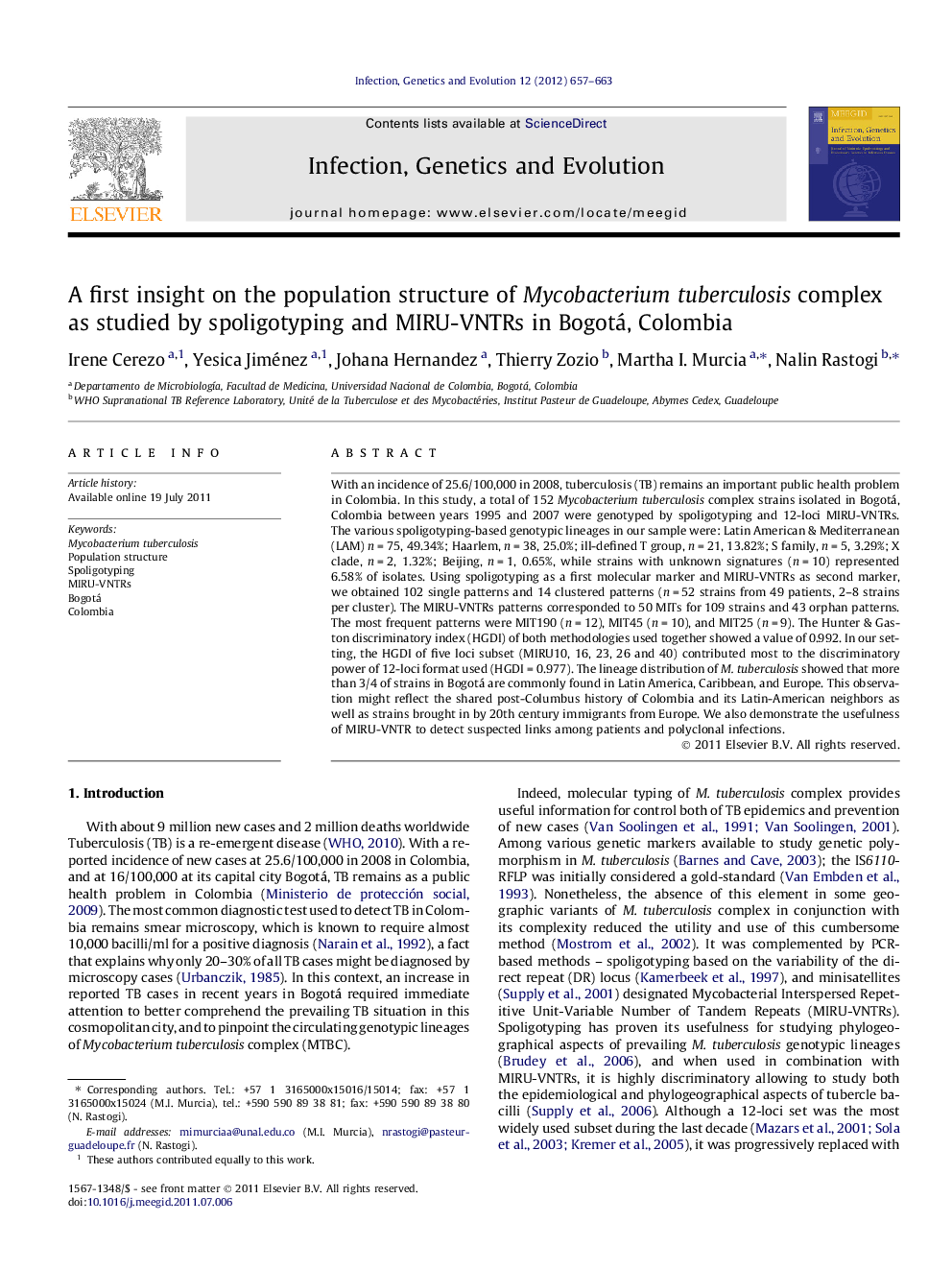| کد مقاله | کد نشریه | سال انتشار | مقاله انگلیسی | نسخه تمام متن |
|---|---|---|---|---|
| 5910422 | 1161353 | 2012 | 7 صفحه PDF | دانلود رایگان |
عنوان انگلیسی مقاله ISI
A first insight on the population structure of Mycobacterium tuberculosis complex as studied by spoligotyping and MIRU-VNTRs in Bogotá, Colombia
دانلود مقاله + سفارش ترجمه
دانلود مقاله ISI انگلیسی
رایگان برای ایرانیان
کلمات کلیدی
موضوعات مرتبط
علوم زیستی و بیوفناوری
علوم کشاورزی و بیولوژیک
بوم شناسی، تکامل، رفتار و سامانه شناسی
پیش نمایش صفحه اول مقاله

چکیده انگلیسی
With an incidence of 25.6/100,000 in 2008, tuberculosis (TB) remains an important public health problem in Colombia. In this study, a total of 152 Mycobacterium tuberculosis complex strains isolated in Bogotá, Colombia between years 1995 and 2007 were genotyped by spoligotyping and 12-loci MIRU-VNTRs. The various spoligotyping-based genotypic lineages in our sample were: Latin American & Mediterranean (LAM) n = 75, 49.34%; Haarlem, n = 38, 25.0%; ill-defined T group, n = 21, 13.82%; S family, n = 5, 3.29%; X clade, n = 2, 1.32%; Beijing, n = 1, 0.65%, while strains with unknown signatures (n = 10) represented 6.58% of isolates. Using spoligotyping as a first molecular marker and MIRU-VNTRs as second marker, we obtained 102 single patterns and 14 clustered patterns (n = 52 strains from 49 patients, 2-8 strains per cluster). The MIRU-VNTRs patterns corresponded to 50 MITs for 109 strains and 43 orphan patterns. The most frequent patterns were MIT190 (n = 12), MIT45 (n = 10), and MIT25 (n = 9). The Hunter & Gaston discriminatory index (HGDI) of both methodologies used together showed a value of 0.992. In our setting, the HGDI of five loci subset (MIRU10, 16, 23, 26 and 40) contributed most to the discriminatory power of 12-loci format used (HGDI = 0.977). The lineage distribution of M. tuberculosis showed that more than 3/4 of strains in Bogotá are commonly found in Latin America, Caribbean, and Europe. This observation might reflect the shared post-Columbus history of Colombia and its Latin-American neighbors as well as strains brought in by 20th century immigrants from Europe. We also demonstrate the usefulness of MIRU-VNTR to detect suspected links among patients and polyclonal infections.
ناشر
Database: Elsevier - ScienceDirect (ساینس دایرکت)
Journal: Infection, Genetics and Evolution - Volume 12, Issue 4, June 2012, Pages 657-663
Journal: Infection, Genetics and Evolution - Volume 12, Issue 4, June 2012, Pages 657-663
نویسندگان
Irene Cerezo, Yesica Jiménez, Johana Hernandez, Thierry Zozio, Martha I. Murcia, Nalin Rastogi,